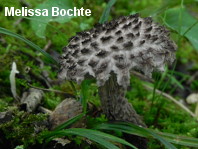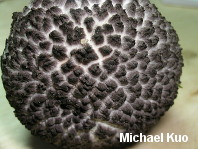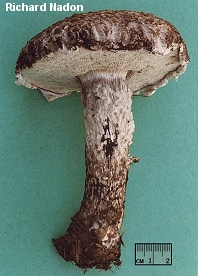| Major Groups > Boletes > Strobilomyces |

|
The Genus Strobilomyces [ Basidiomycota > Boletales > Boletaceae . . . ] by Michael Kuo There are only a few North American members of this genus, and they are relatively easy to separate from the other boletes; they are shaggy to scaly, blackish or grayish mushrooms with partial veils and woolly stems. Their flesh stains pinkish or orangish red when sliced, then slowly turns black. Species of Strobilomyces are mycorrhizal with hardwoods in eastern North America. Many of the reigning concepts in Strobilomyces taxonomy have been recently overturned, and more changes are almost certainly on their way. Petersen and collaborators (2012) studied three European species with reticulate spores: Strobilomyces strobilaceus (first named by Scopoli in 1770), Strobilomyces floccopus (Vahl, 1797), and Strobilomyces strobiliformis (Dickson, 1785). In short, the researchers determined that it was difficult to maintain these three separate European species on the basis of morphology--and, when DNA results were factored in, it became impossible, since specimens identified as all three species turned out to be phylogenetically the same. Thus, according to the rules of taxonomy, the oldest name in the group gets the prize; Petersen and collaborators determined that the European species with reticulate spores should be called Strobilomyces strobilaceus, while Strobilomyces floccopus and Strobilomyces strobiliformis became deprecated synonyms. In North America, however, we can't just replace what we have been calling "Strobilomyces floccopus" with the name Strobilomyces strobilaceus, because Petersen and collaborators included North American collections in their study and discovered that they were not a phylogenetic match to the European collections. This means that our North American, reticulate-spored species lacks a name. In fact, further research might easily determine that we have more than one North American species with reticulate spores (Nancy Weber's "Strobilomyces dryophilus," for example, should be studied). All of this means that for the time being identifications of Strobilomyces species on our continent should be seen as tentative; we know there will be new species, but we don't know how many there will be, or whether they will be easily separable without a DNA laboratory. Before DNA studies, Weber (1985) thought that "[a]bout four taxa in the genus Strobilomyces occur" in the southern United States alone (although she only described two and alluded to a third). An extensive study devoted to North American collections is clearly needed. |
|
|
Key to 3 Strobilomyces Taxa in North America
(References used for this page can be found in the reference list for boletes.) This site contains no information about the edibility or toxicity of mushrooms. Cite this page as: Kuo, M. (2013, December). The genus Strobilomyces. Retrieved from the MushroomExpert.Com Web site: http://www.mushroomexpert.com/strobilomyces.html © MushroomExpert.Com |



